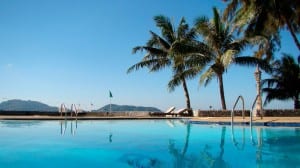Water conservation tips for Scottsdale, AZ swimming pool owners
When you’re having a swimming pool constructed, you understand you need to make arrangements to have the pool filled and you can do that either with the hose from your home or you may opt to have water trucked in. Be aware that in some areas of the country, the water you use will also generate a sewage usage charge — you may want to talk with your particular municipality to see if there is a fee and if it can be waived because you will be using the water, but not generating any “sewage usage.”
Once the pool has been filled, the swimming pool contractors from SwimRight Pools explain that there will be an ongoing cost of water 
Swimming pool contractors in Scottsdale, Arizona offer these steps to help you conserve water in your swimming pool or spa. These tips will also help keep money in your wallet:
- A leaking swimming pool will obviously lead to water loss and the cost and need to refill it. One of the easiest ways to determine whether you have a leak or evaporation? The “bucket test.” Fill a bucket with water, mark the water level in the bucket, place it next to your pool and measure whether the water in the bucket evaporates at the same rate as your pool does. Also, check for damp spots around the pool. Loose or cracked tiles can also be the sign of a leaking pool or hot tub.
- Not using a cover can lead to up to an inch of water loss a week – especially in the summer months and that equates to close to a loss of close to 7,000 gallons a year! You pool cover can also conserve heat and lead to a savings on heating costs and it can also reduce the need for additional chemical use.
- When the pool is backwashed your filters that uses extra water. Keeping the pool and filters clean eliminates the need for frequent backwashing.
- The swimming pool doesn’t need to be full to the brim. Keep the water about an inch above the bottom pool tile. This will help keep water in when swimmers are splashing around.
- Lowering the temperature on your pool a degree or two will help save money and slow down the rate of evaporation.
- Add chlorine when the sun goes down. If you add chlorine in the daytime, the sun quickly dissipates the chlorine.
- Strategic planting of trees, shrubbery and fencing or privacy barriers can cut down on evaporation caused by the wind.
Ask your pool contractor for advice on how to check whether your pool is leaking and for further advice on how to save money and prevent pool water evaporation.


